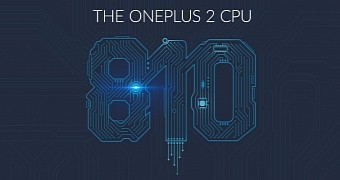Chinese company OnePlus has been pretty cryptic about its upcoming flagship smartphone dubbed OnePlus 2, which is expected to be officially unveiled in Q3 2015.
But not anymore, as the handset maker has just announced that OnePlus 2 will be powered by the controversial Qualcomm Snapdragon 810 chipset.
Even though the OnePlus 2 will be equipped with v2.1 of the chipset, it will probably have the same overheating issues that Xperia Z3+ and Xperia Z4 are currently struggling with.
However, OnePlus is pretty optimistic about Qualcomm's chipset and claims in a statement that it won't overheat inside the OnePlus 2.
“Although there have been reports that the 810 runs warmer than its predecessors, we assure you that we have taken all the necessary precautions and beyond to prevent this from occurring in the 2.
“We worked very closely with Qualcomm’s engineers to integrate an improved version of the chipset (v2.1) in the OnePlus 2, and fine-tuned both hardware and software. The 2 will be ‘cooler than ever.’”
Even if it won't overheat, it's still a bad idea
There's a high chance that HTC and Sony Mobile thought the same and their flagship smartphones still had overheating issues. Fortunately, the Taiwanese company delivered a software update before the One M9 went on sale, which addressed these overheating issues.
We can't say the same for Sony's Xperia Z3+ and Xperia Z4, which are still plagued by these problems until a software update that's already been promised makes its way onto both devices.
Anyway, OnePlus also mentions that when it comes to software, OxygenOS will be optimized to work smoothly with the Snapdragon 810 processor.
Apparently, the Chinese company created its own technology, which handles a wide range of tasks for the chipset inside the two of the eight included CPU cores.
“For example, one or two of the larger processors would be used for graphics-heavy gaming, while in contrast, the small processor would be used for simple text messaging.”

 14 DAY TRIAL //
14 DAY TRIAL //